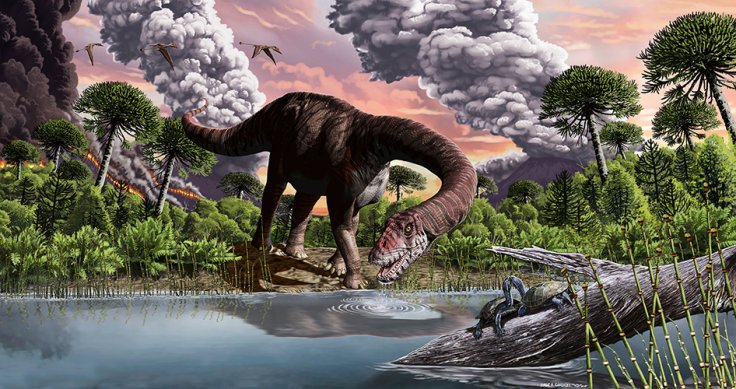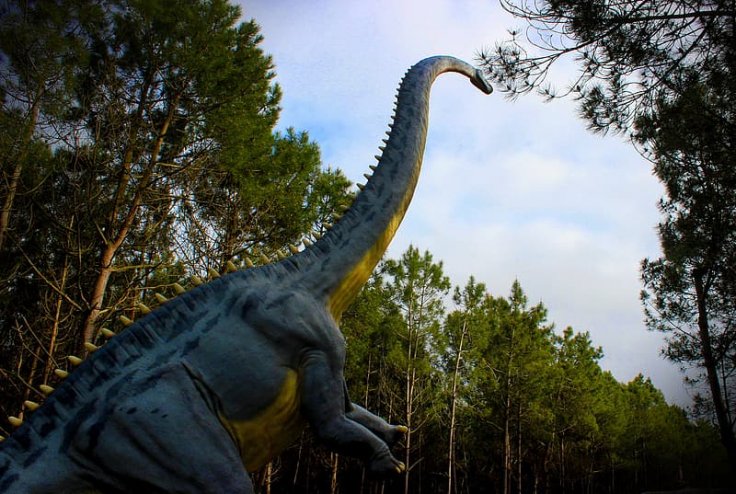The very mention of dinosaurs creates mental pictures of massive creatures with whip-like tails and necks, large bulky bodies, and moving around on all-fours; thanks to Jurassic Park. However, one often wonders what could have led to some of them reaching enormous proportions. Now, scientists have an unbelievable answer—Global Warming.
An international team of scientists discovered the fossils of a new species of sauropod—herbivorous dinosaurs characterized by large sizes, four-legged stance, and long tails and necks—in Argentina. Christened Bagualia alba, it is believed to be one of the oldest and largest sauropods unearthed. Closer analysis of the fossils revealed that it could be from 179 million years ago, a time when the climate was said to have shifted toward a hotter and dry climate; perhaps serving as the reason for its size.
Colossal Wonders of Prehistoric Times

Sauropods such as the popular Brachiosaurus were truly gigantic creatures. They belonged to an important subgroup of dinosaurs known as Sauropoda; hence, the name sauropods. Along with the distinctive tails and large bodies, they were also known to have small heads and thick column-like legs. They are considered to be among the largest land-living animals to have existed, who reached lengths of 5m-40m (16ft-135ft) and weights of up to 70 tons (around 64,000 kgs).
While these are the general attributes associated with sauropods, scientists say that these gargantuan creatures did not appear straight away at the dawn of the dinosaurs. During the first 50 million years or so of their evolutionary beginnings, dinosaurs belonging to a natural group or clade known as Sauropodomorpha—the lineage to which sauropods belong—were constituted by several herbivorous species of bipedal and quadrupedal creatures.
Though some reached large sizes of up to ten meters, the group also consisted of dinosaurs that were no bigger than modern-day goats.

Additionally, these reptiles also had sleeker teeth, which suggests that they sought their nourishment from relatively soft and dense vegetation. Nevertheless, as the early Jurassic period drew to an end approximately 180 million years ago, all of the Sauropodomorpha groups went extinct, except the sauropods, who not only survived but thrived and grew to awe-inspiring sizes.
So the question is—What changes in the Early Jurassic period led to such drastic reshaping of conditions? The discovery of Bagualia alba helped the authors arrive at an answer.
The King of Giants

In the Chubut Province of Argentinean Patagonia, the researchers discovered the nearly complete fossilized skull and bones of the sauropod which they named Bagualia alba. Through their examination, the authors not only established that it was one of the largest and oldest sauropods to have been found, but also the conditions in which it could have existed. It posited that the sauropod belonged to the later stratum of sauropods, precisely dated to 179 million years ago—shortly after the other sauropodomorph groups vanished mysteriously.
Within rock layers, the team found fossilized remains of plants belonging to the period slightly before and during the time that the Bagualia alba lived in. This provided them with evidence to decipher the ecological and climatic conditions that it existed in. According to the gathered data, there are strong indications that the climate underwent a comparatively rapid change around 180 million years ago.

From a humid and temperate climate where a wide variety of vegetation was abundantly available, the climate became one that was extremely seasonal, very dry, and hot. Flora became less diverse and appeared in forms such as conifers that evolved to survive the intensely hot climates. What led to these aggressive environmental changes?
A Hotter World
The authors believe that these changes could have been steered by a greenhouse effect due to the increased presence of gases such as CO2 and methane—the very gases fuelling our current rise in temperatures—due to increased volcanic activity. Evidence for the occurrence can be found across many southern continents (e.g) the Drakensberg in southern Africa.

As several groups of sauropodomorphs had slender teeth that were equipped to feed on easily available and softer flora found before the global warming event, they were ill-adapted for the vegetation that arose later. Sadly, this led to their extinction. The sauropods, who possessed favorable dentition—arrangement and development of teeth—survived, thrived, and emerged as the most dominant herbivorous dinosaurs during the period.
It is likely that the adaption to feeding on the new vegetation resulted in these animals growing to colossal sizes. In order to cope with the kind of vegetation, these creatures would have required large digestion chambers. Thus, this also played a role in several species reaching much larger sizes.









